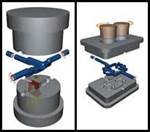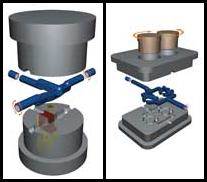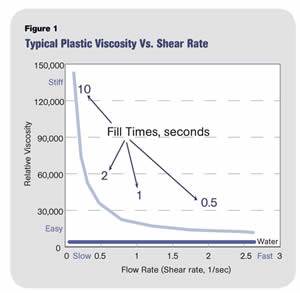Why Multi-Cavity Molds Fill Unevenly
Balanced filling is critical for making identical parts, achieving high CPKs, holding tight tolerances, and getting “good” data from design of experiments.
In my March 2010 column I wrote about the importance of uniform filling or balanced flow for each cavity of a multi-cavity mold. Balanced filling is critical for making identical parts, achieving high CPKs, holding tight tolerances, and getting “good” data from design of experiments (DOEs).
Balanced flow is critical for both filling and packing (filling influences packing). What I did not cover in the March article were the reasons for uneven or imbalanced filling. Here are the “classic” reasons for non-uniform filling of a multi-cavity mold (let me know if I missed any). The real problem is determining which one or combination of these is affecting your parts:
1. Non-uniformly melted plastic. Unmelted or partially melted plastic can disrupt flow in the runner, gate, or part. This may seem like a minor issue, yet my experience tells me it is significant. For example, temperature control of the nozzle tip and body is notoriously problematic, especially with cold runners. Poor screw design may also result in non-uniform melt. Then there is temperature control of the manifolds and tips in hot-runner systems. How many of you are setting some “unusual” temperatures to get the hot runner to function?
2. Differential venting among the cavities or flow path. Yes cold runners should be vented. Air, water vapor, off-gases, or volatiles from the polymer can build pressure in cavities and restrict filling. I demonstrate this at every one of my seminars. When troubleshooting venting issues for fill balance, one trick is to make short shots at 90+% full and 65-80% full to see if the balance changes.
3. Non-uniform cooling of the mold, hot-runner system, or hot tips. Plugged or partially plugged water lines; water lines too close to the parts or too far away; coolant taking the path of least resistance; laminar flow; air trapped in a coolant channel; or other equipment coming on and off line can all wreak havoc with proper cooling. While rarely done, a case can be made for regulating water coolant flow separately through each channel of your molds.
4. Part design, particularly non-uniform wall thickness. If you have thick and thin sections in the part, the thick section will fill relatively easily compared with the thin section. If gated into the thick section, flow may “hesitate” at the thick-thin junction, causing a seesaw filling pattern. This factor must be considered in “living hinge” applications.
5. Lack of proper velocity control during filling. Too many profiled velocity changes; running the process pressure-limited; or setting up with different fill times—these are big culprits for filling imbalances. Fill time basically establishes shear rate, which in turn establishes viscosity. Varying fill time (shear rate) from shot to shot, run to run, or machine to machine provides a “different” process due to huge changes in viscosity. Change the viscosity and you can the change fill pattern.
6. Gates not all the same size. No problem, as this is easy to check with a pin gauge, right? Wrong. Relatively few pin gauges measure gate land length. It is difficult and time-consuming to measure land length, but it’s essential because gate land length establishes pressure drop. To achieve balanced filling you need each gate to provide identical pressure drop. There is a reason most mold builders have a rule for maximum land length.
7. Unbalanced flow path. If flow distance and/or path geometry are not identical, non-uniform filling is inevitable.
8. Laminar flow. This is perhaps most sinister reason on my list, because you can have everything else down perfectly and still have poor balance in filling. Polymer melt flows in layers (laminar flow) of different velocity, temperature, shear rate, and viscosity. There are concentric layers within any given flow path—a nozzle, runner, manifold, gate or part. Shear is the prime determinant for non-uniform viscosity. The melt layer near the wall of the flow path will see the highest shear, providing the lowest viscosity (easiest flow). The center path has the lowest (or zero) shear, so its viscosity is the highest (stiffest flow). In the sprue, the concentric layers are symmetrical, but as soon as you split or branch the flow path, this critical symmetry goes out the window and you have an imbalance in shear rate across the layers resulting in unbalanced flow of the layers.
Even in a geometrically balanced (or “naturally balanced”) runner system, runner branching upsets the flow symmetry and all cavities do not fill evenly. It is common to see the inside cavities fill earlier than outside cavities. To achieve identical parts you must maintain the laminar flow symmetry in order to control the rheology (viscosity) of the polymer flow to fill all cavities evenly.
Dr. John Beaumont of Beaumont Technologies Inc., Erie, Pa. has developed a five-step procedure that determines if the problem of flow balance is due to steel problems (like gate-size variations) or because of this inherent laminar flow phenomenon. (Check out ptonline.com for articles on this subject by Dr. Beaumont in Feb. 2007 and Nov. 2008).
Related Content
Where and How to Vent Injection Molds: Part 3
Questioning several “rules of thumb” about venting injection molds.
Read MoreUnderstanding Melting in Single-Screw Extruders
You can better visualize the melting process by “flipping” the observation point so the barrel appears to be turning clockwise around a stationary screw.
Read MoreA Systematic Approach to Process Development
The path to a no-baby-sitting injection molding process is paved with data and can be found by following certain steps.
Read MoreInjection Molding: Focus on these Seven Areas to Set a Preventive Maintenance Schedule
Performing fundamental maintenance inspections frequently assures press longevity and process stability. Here’s a checklist to help you stay on top of seven key systems.
Read MoreRead Next
Unbalanced? No Shortage of Ways to Fix Uneven Filling of Multi-Cavity Molds
The accepted ground rule for balancing melt flow in multi-cavity injection molds is to achieve equal flow distance from the injection point to each cavity.
Read MoreGet Control Of Flow in the Mold
A novel technology allows injection molders to alter the flow pattern inside the cavity and balance the filling of multiple cavities by means of an external mold adjustment while the tool remains in the press. In this exclusive article, the system's inventor explains how it works.
Read MoreBalanced Filling Is Critical for Holding Molding Tolerances
Processors face a multitude of challenges whenever they approach an injection molding machine.
Read More
.jpg;width=70;height=70;mode=crop)





















